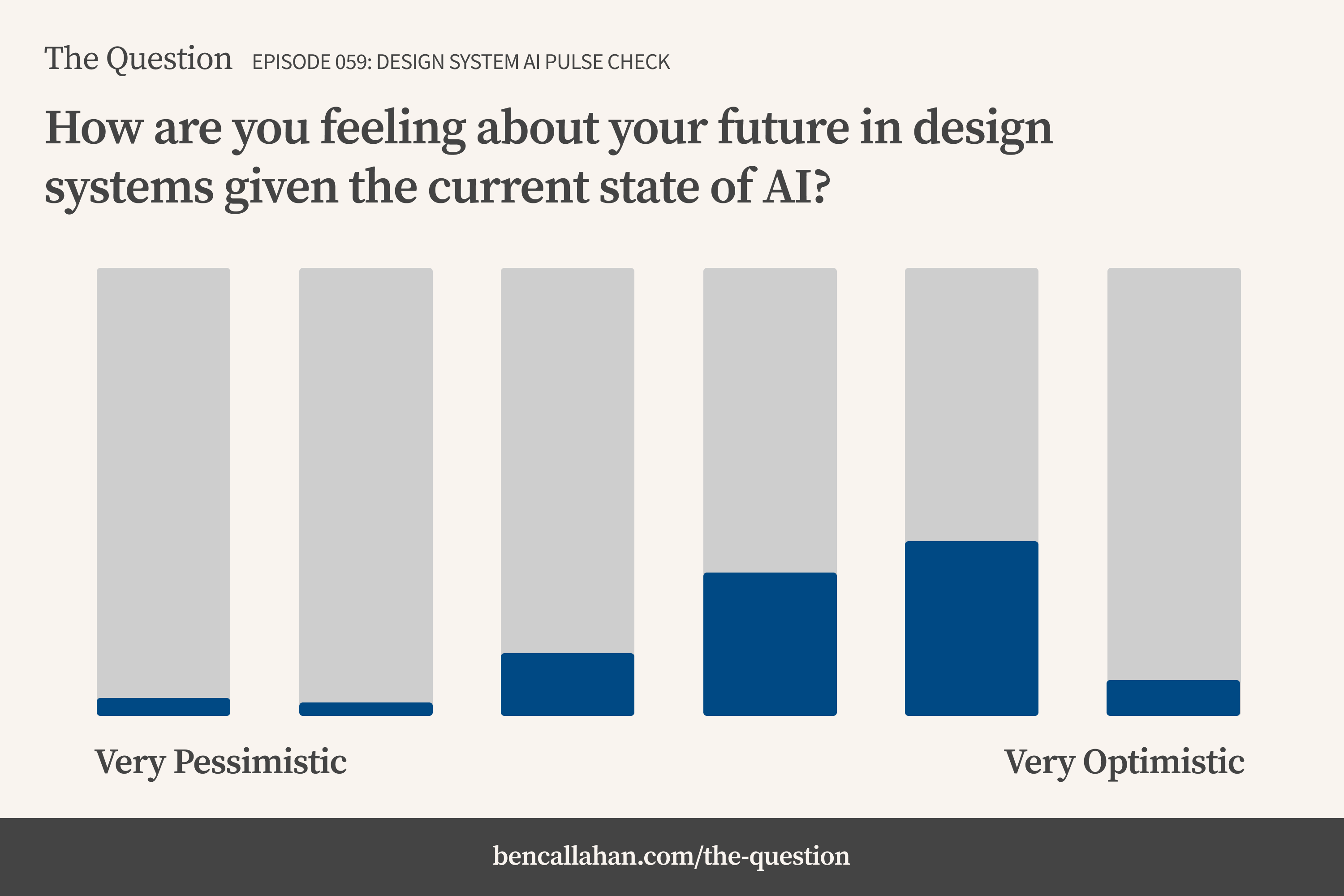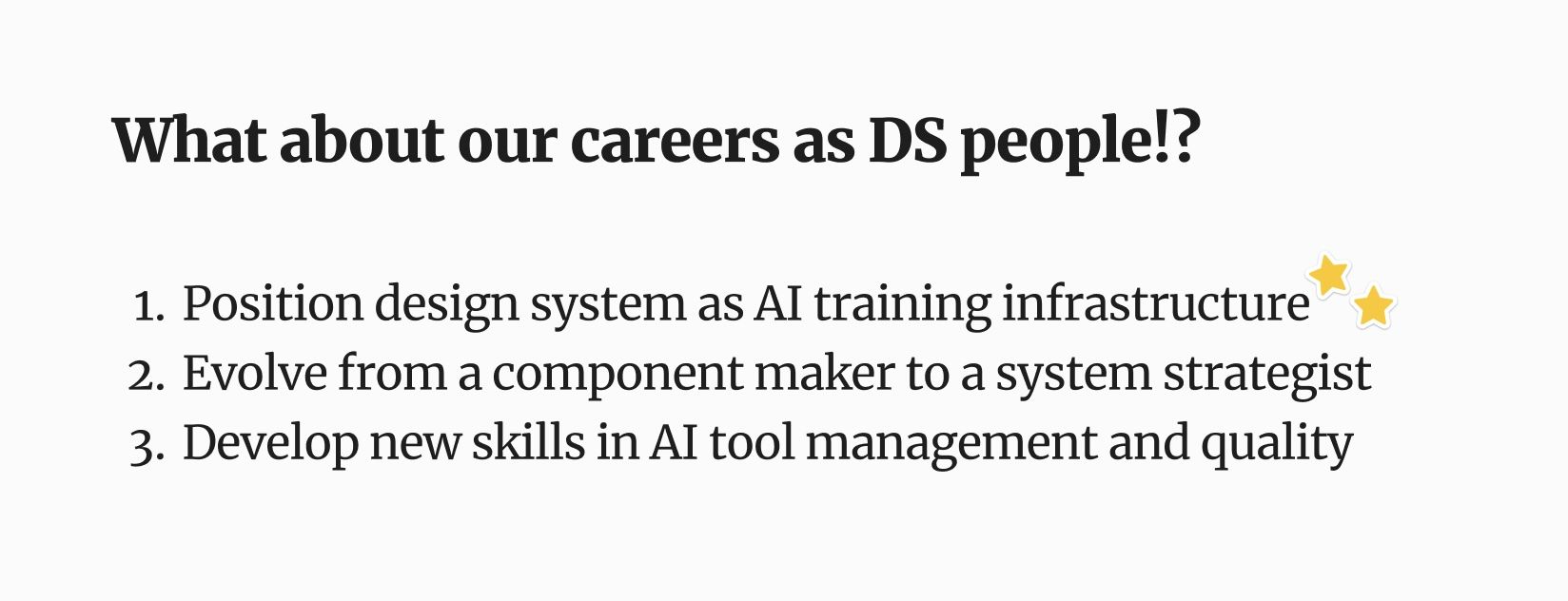Outcomes Over Output: Design Systems and AI
Nobody knows exactly where all of this is going, and that’s the fun part…
Last week, as part of my bi-monthly research show, The Question, I gathered with a group of very thoughtful design system practitioners to talk about the role of AI in our design system programs. This wasn’t a hype session, it was a real conversation grounded in data from 74 of you who responded to three simple questions:
- How are you feeling about your future in design systems, given the current state of AI?
- Why do you feel that way?
- How are you actually using AI today to support your design system work?
TLDR: AI is certainly shifting our work, but not in the way leadership often assumes (or even wants).
Cautiously optimistic
I’ve been part of a few conversations about AI in design systems and they seem to usually live on one end of a spectrum. Some are filled with existential dread, others feel like fanboy excitement. Some are focused on how AI will replace us while others are about how much more we’ll be able to accomplish. When we asked you all how you were feeling about all of this, you came back with an average rating of 3.3 on a zero to five point scale. That may not sound thrilling, but it does feel like a marked improvement from past conversations I’ve had.
 When asked how they are feeling about their future in design systems given the current state of AI, most respondents were on the optimistic side of the scale.
When asked how they are feeling about their future in design systems given the current state of AI, most respondents were on the optimistic side of the scale.
The spectrum of feelings were represented well by these two responses:
“I feel like someone is pulling the rug from underneath me.”
“I think there has never been a more exciting time for us DS practitioners.”
After reading through all your answers, the way I would describe our combined sentiment is “cautiously optimistic.”
Leadership wants magic
One of the most consistent themes from the discussion was the disconnect between practitioners and leadership. Folks from Dell, Target, Spotify, and elsewhere shared stories of leaders pushing for ways to integrate AI into workflows and products for fear of being left behind. Given the hype, this is an understandable feeling.
In the deep dive, Daniel shared:
“We started with an AI chatbot for support and leadership thought it would solve all our problems. In reality, it only answers the most basic questions, and we still need a real team.”
Juli echoed this sentiment and shared how she’s seen high-profile AI examples really shift the narrative from leadership. The challenge is helping our leaders understand the gap between those examples and genuinely useful changes to our workflows.
Brandon shared that he’s had success in helping his leaders understand this gap by communicating that there’s a lot of work to do to take these examples, identify the successful patterns, and bring them into our workflows so we can improve our outcomes.
Of course, that’s adding even more to our plates. Sarah expressed this succinctly:
“Most design system teams can’t even do what they need to do now with the people they have, let alone develop smart AI functionality. It feels like we’re treading water.”
There were a lot of nodding heads as we discussed how leadership is often captivated by the shiny output: vibe-coded prototypes, AI-generated slides, code spun up in seconds. But those outputs often lack what matters most, products that are truly ready to serve a diverse user-base at scale.
The real value isn’t the output
All this talk of how AI is perceived by our leaders sounded familiar to a few of us who have been in the industry a while. Elyse first called this out:
“Leadership is just behaving the same as they always have. Output is cheap and always has been—we make boxes on screens. The output is not the thing we’re there to provide. The value is in the strategy, the process, and the decision-making.”
She was prompting us to realize, we have to be smart about what we choose to outsource to AI. We have to do the work to understand where the humans shine and where the robots shine.
I issued a challenge in response to this. As a computer science major who chose AI as my specialization back in undergrad, I remember taking physiological psychology classes that were part of the artificial intelligence track. This is a branch of science dedicated to understanding how the brain and nervous system influence our thoughts, feelings, and actions. The reason they had us studying the brain is because AI is modeled after the brain. My challenge was this: Sure, leadership is behaving as they always have, but maybe AI is different. If the intent behind AI is for an algorithm to mimic human reason and decision making, perhaps these tools are the ones that actually can replace us?
Kevin responded swiftly by saying that he doesn’t see AI as just another tool. Instead, he likened it to the invention of the factory. Just as the time before the industrial revolution was more about hand-crafted goods, perhaps that’s where we are now, on the precipice of a fully transformed society at the hands of AI.
A bigger mindset shift
This philosophical debate was capped off by Sandra asking us to imagine a future that is quite different from our current day-to-day:
“We’re not really able to even imagine what AI can actually do for us. It’s a bigger mindset shift. The future may have no visible UI at all.”
Elyse continued this line of thinking:
“What if components were effectively little prompts? We could just generate the UI every time, and if we needed to change something, it would be easy to refactor everywhere.”
Others chimed in about how on-demand interfaces and ephemeral UI are already here. And this thread of the deep dive brought us back to the idea that…
Design systems are inputs, not outputs
We’ve long talked about design systems as a source of truth or agreement. But in an AI-based workflow, those same systems become the ingredients. In other words, the best use of AI in design systems isn’t to write the documentation or make the components, it’s to train the AI with those things.
This thinking provides a nice response to leaders chasing the shiny new thing. Perhaps if we position our design systems as the context engines for AI-driven product creation, we can show how it’s the combination of AI and design systems that is the future of our products.
So, what does our role look like if this is the future?
Redefining roles, again
There’s a growing sense that AI is changing roles in ways that aren’t always comfortable. Some felt a little territorial or insecure, others were energized by the possibilities.
Caroline summed it up:
“I’m not scared of AI taking my job or becoming irrelevant. I’m scared it’s going to alter my job so much it takes out what I love about it—doing the work.”
Kevin reframed the opportunity:
“We have to move from thinking about the end product to thinking about prompts, models, and datasets. That’s where the value will be.”
In preparation for the deep dive, I had already synthesized three key ideas for how our roles need to shift in this new world.
 Three things we can begin doing now to prepare for this brave new world: 1) position design systems as AI training infrastructure, 2) evolve from component makers to system strategists, and 3) develop new skills needed to manage and use AI tooling.
Three things we can begin doing now to prepare for this brave new world: 1) position design systems as AI training infrastructure, 2) evolve from component makers to system strategists, and 3) develop new skills needed to manage and use AI tooling.
How to prepare
- Position the design system as AI training infrastructure
- Evolve from a component maker to a system strategist
- Develop new skills in AI tool management and quality
In the immediate future, that also means we can do the work to consider how our product organizations should be using AI responsibly. Caroline shared an example of some of the hard work she and her team have done to document this. Offering this kind of clarity to our teams helps create a sense of governance and stability when the technology feels like it’s flying by.
From experimentation to infrastructure
As a community of practice, there’s agreement that we’re in the messy middle. Most of you that answered The Question this week are doing some amount of experimenting. And most of you also shared that you’re having a hard time making those experiments valuable in real-world use cases.
Daniel summed it up, saying:
“For POCs and prototypes, AI is really amazing. For final products… meh.”
But there were a few folks who have managed to take those experiments into infrastructure. Davy had some advice for this very scenario:
“Be targeted. Create different agents for different knowledge domains. Index common questions. Don’t just build something to check the AI box.”
And when you find valuable approaches, some folks are even source-controlling prompts to keep things consistent. Overall, it felt like our conversation drifted away from “should we use AI?” toward “how do we make AI work for us?”
Looking Ahead
Of course, AI will keep getting better—the models will evolve. But the biggest shifts don’t come from new tools, they come from how we choose to use them.
If your definition of a design system is broad enough, your design system is uniquely positioned here. They’re not just repositories of components, they’re cultural artifacts and frameworks for thinking. In an AI-driven world, that context is more valuable than ever.
If you want to explore this further, the full data set is here and the collaborative notes from our deep dive conversation are here.
Episode 059 was sponsored by Omlet
A brief word of thanks to Omlet for helping to make this episode possible. It takes a lot of work to run these sessions, both for me and our co hosts. Having an organization step up to support this research and our community is meaningful. If you want better visibility into how your design system is actually being used, Omlet is becoming the default standard for design system analytics.
Check out their special offer for members of The Question community.
Find your community
Curious how others are doing this? Come hang with us in Redwoods. It’s a space for people who want to support each other on the journey of building better design system programs.
Learning mode
I am continually inspired by the people who participate week after week to dive into the answers we gather. Each one of you shows up in learning mode. Because of that, we all walk away with broadened perspectives and an appreciation for the experiences we each bring to these conversations.
To those of you who attended, thanks for joining with such a gracious posture.
Resources
- Review the Episode 059 Raw Data
- Review the Episode 059 FigJam
- Watch the Episode 059 Recap
- Connect with Kevin or Ben on LinkedIn
- Check out previous episodes of The Question
Thank you
Many thanks to all who participated.
If you missed out this week, sign up for The Question and be ready to answer next time.
Writing Design Systems The Question Featured
Join Redwoods, a design system community.
Sign up for The Question, a weekly design system deep dive.
Explore more of my writing and speaking.
Or, inquire about design system coaching